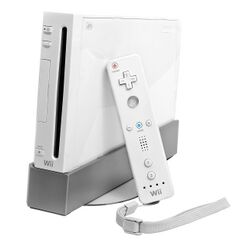Wii
From Sega Retro

| ||||||||||||||||||||||||||||||||||||||||

| ||||||||||||||||||||||||||||||||||||||||
| Wii | ||||||||||||||||||||||||||||||||||||||||
|---|---|---|---|---|---|---|---|---|---|---|---|---|---|---|---|---|---|---|---|---|---|---|---|---|---|---|---|---|---|---|---|---|---|---|---|---|---|---|---|---|
| Manufacturer: Nintendo | ||||||||||||||||||||||||||||||||||||||||
|
The Wii (pronounced "we"), codenamed Revolution, is a video game console created by Nintendo as the successor to the Nintendo GameCube in 2006. It competed in the seventh generation of home video game consoles, in which, due to a radical shift in marketing strategy by Nintendo, it came to dominate, selling almost 100 million units worldwide. The Wii was succeeded by the Wii U in late 2012.
Contents
Overview
Rather than opt for the traditional tactic of creating a system significantly more powerful to its predecessor, Nintendo designed the Wii to capitalise on what it thought would be the future of gaming - new and innovative ways to play paired alongside a marketing strategy which targeted who Nintendo deemed as "non-gamers". The result was a system not too dissimilar from the GameCube, but instead utilised motion control - Wii Remotes, which not only responded to button presses like traditional controllers, but could be moved and rotated by the player in the real world, creating an effect on-screen.
Nintendo put its innovative controller ahead of traditional aspects such as graphics and processing power, creating a system capable of playing a very different selection of video games than its rivals. It was seen as a major shift in strategy which was also mirrored to some extent by the already available Nintendo DS handheld, and Nintendo worked this concept to a great extent, capitalising on similar extensions such as the Wii Balance Board and Wii Motion Plus. Third-parties also got on board in the early years trying to persue a similar strategy, and from Nintendo's perspective it paid off, creating one of the most successful home consoles in history.
However, by 2010 much of the novelty had worn off - those in favour of traditional console gaming experiences migrating over to the Xbox 360 or PlayStation 3 to capitalise on the superior technology on offer. Third-party developers saw their games suffer on the Wii, with only first-party Nintendo games being seen to utilise the technology in meaningful ways. As a result, although more Wii consoles outsold the competition for much of the generation, software attachment rates were low, and many third-party publishers abandoned the system entirely. Later models stripped away GameCube backwards compatibility, and slowing sales caused Nintendo to develop and release a successor, the Wii U, built to regain the support the company had lost.
Sega support
Like many publishers, Sega was optimistic with the Wii when it first launched, and the vastly differing specifications to the Xbox 360 and PlayStation 3 led to the creation of many Wii exclusive games. Super Monkey Ball Banana Blitz was a launch title for the console, and was followed by titles such as Sonic and the Secret Rings, Samba de Amigo and NiGHTS: Journey of Dreams. Sega also published games attempting to appeal to more traditonal gamers such as The House of the Dead: Overkill and in the west, the controversial MadWorld. It also published High Voltage Software's The Conduit, expected to be a top FPS for the system.
Though initially enthusiastic about the Wii, by 2010 Sega were merely releasing multi-platform games and niche titles such as Gunblade NY & LA Machineguns, axing support entirely by the end of 2011. It is assumed, much like other third-parties, that Sega's titles did not sell particularly well on the console, with output instead being directed at the Wii's rivals with the expectation of generating more profit.
Sega was a major supporter of the Wii's Virtual Console service, allowing the system to play downloadable Sega Mega Drive and Sega Master System games, as well as a small selection of arcade games. Support for this service also began to deteriorate after 2010, although this may have simply been down to a lack of games to re-release at this point.
List of Sega games for the Wii
- 428: Fuusa Sareta Shibuya de (2008)
- 428: Fuusa Sareta Shibuya de Taikenban (2008)
- Advanced Busterhawk Gley Lancer (?)
- Alex Kidd in Miracle World (?)
- Alex Kidd in Shinobi World (?)
- Alex Kidd in the Enchanted Castle (?)
- Alex Kidd: The Lost Stars (?)
- Alien Soldier (?)
- Alien Storm (?)
- Alien Syndrome (2007)
- Altered Beast (?)
- Atomic Runner (?)
- Bahamut Senki (?)
- Bio-Hazard Battle (?)
- Bleach: Shattered Blade (2006)
- Bleach: Versus Crusade (2008)
- Bonanza Bros. (?)
- Boogerman: A Pick and Flick Adventure (?)
- Captain America: Super Soldier (2011)
- Chindouchuu! Pole no Daibouken (2009)
- ClayFighter (?)
- Columns (?)
- Columns III: Revenge of Columns (?)
- Comix Zone (?)
- Conduit 2 (2011)
- The Conduit (2009)
- Crack Down (?)
- Daisy Fuentes Pilates (2009)
- Doraemon Wii: Himitsu Dougu Ou Ketteisen! (2007)
- Dr. Robotnik's Mean Bean Machine (?)
- Dragon Slayer: The Legend of Heroes (?)
- Dragon Slayer: The Legend of Heroes II (?)
- Dyna Brothers (?)
- Dyna Brothers 2 (?)
- Dynamite Headdy (?)
- Earthworm Jim (?)
- Earthworm Jim 2 (?)
- Ecco Jr. (?)
- Ecco the Dolphin (?)
- Ecco: The Tides of Time (?)
- Enduro Racer (?)
- ESWAT: City Under Siege (?)
- Eternal Champions (?)
- Fantasy Zone (?)
- Fantasy Zone II: The Tears of Opa-Opa (?)
- Forgotten Worlds (?)
- Fushigi no Dungeon: Fuurai no Shiren 3: Karakuri Yashiki no Nemuri Hime (2008)
- Gain Ground (?)
- Galaxy Force II (?)
- Ghost Squad (2007)
- Ghouls'n Ghosts (?)
- Golden Axe (?)
- Golden Axe II (?)
- Golden Axe III (?)
- The Golden Compass (2007)
- Guilty Gear XX Accent Core (2007)
- Gunblade NY & LA Machineguns (2010)
- Gunstar Heroes (?)
- Gynoug (?)
- Hokuto no Ken (?)
- Hokuto no Ken: Shin Seikimatsu Kyuuseishu Densetsu (?)
- The House of the Dead 2 & 3 Return (2008)
- The House of the Dead: Overkill (2009)
- The Hybrid Front (?)
- Illmatic Envelope (2008)
- Imabikisou: Kaimei Hen (2008)
- The Incredible Hulk (2008)
- Iron Man (2008)
- Iron Man 2 (2010)
- Jambo! Safari: Animal Rescue (2009)
- Jissen Pachi-Slot/Pachinko Hisshouhou! Sammy's Collection Hokuto no Ken Wii (2007)
- Kid Chameleon (?)
- Kirby's Avalanche (?)
- Landstalker: The Treasures of King Nole (?)
- Langrisser (?)
- Langrisser II (?)
- Let's Catch (2008)
- Let's Tap (2008)
- Light Crusader (?)
- Lord Monarch: Tokoton Sentou Densetsu (?)
- M.U.S.H.A. (?)
- MadWorld (2009)
- Mario & Sonic at the London 2012 Olympic Games (2011)
- Mario & Sonic at the Olympic Games (2007)
- Mario & Sonic at the Olympic Winter Games (2009)
- Mega Turrican (?)
- Mercs (?)
- Miburii & Teburii (2008)
- Monster World IV (?)
- Nancy Drew: The White Wolf of Icicle Creek (2008)
- NiGHTS: Journey of Dreams (2007)
- Party Quiz Mega Q (?)
- Pepenga Pengo (?)
- Phantasy Star (?)
- Phantasy Star II (?)
- Phantasy Star III: Generations of Doom (?)
- Phantasy Star IV: The End of the Millennium (?)
- Phelios (?)
- Pitfall: The Mayan Adventure (?)
- Planet 51: The Game (2009)
- Powerball (?)
- Pulseman (?)
- Puyo Puyo (?)
- Puyo Puyo 7 (2009)
- Puyo Puyo Tsuu (?)
- Puyo Puyo! (2007)
- Puyo Puyo!! (2011)
- Puzzle & Action: Ichidant-R (?)
- Puzzle & Action: Tant-R (?)
- R-Type (?)
- Rent A Hero (?)
- The Revenge of Shinobi (?)
- Ristar (?)
- Rolling Thunder 2 (?)
- Sakura Wars: So Long, My Love (2010)
- Samba de Amigo (2008)
- Secret Command (?)
- Sega Bass Fishing (2008)
- Sega Fun Pack: Sonic and the Secret Rings & Super Monkey Ball Banana Blitz (2009)
- Sega Superstars Tennis (2008)
- Shadow Dancer: The Secret of Shinobi (?)
- Shanghai II: Dragon's Eye (?)
- Shining Force (?)
- Shining Force II (?)
- Shining in the Darkness (?)
- Shinobi (?)
- Shinobi III: Return of the Ninja Master (?)
- Sonic & Knuckles (?)
- Sonic & Sega All-Stars Racing (2010)
- Sonic 3D: Flickies' Island (?)
- Sonic and the Black Knight (2009)
- Sonic and the Secret Rings (2007)
- Sonic Chaos (?)
- Sonic Colours (2010)
- Sonic Riders: Zero Gravity (2008)
- Sonic the Hedgehog (?)
- Sonic the Hedgehog (?)
- Sonic the Hedgehog 2 (?)
- Sonic the Hedgehog 2 (?)
- Sonic the Hedgehog 3 (?)
- Sonic the Hedgehog 4 Episode I (2010)
- Sonic the Hedgehog Spinball (?)
- Sonic to Himitsu no Ring Taikenban (2007)
- Sonic Unleashed (2008)
- Sorcerian (?)
- Space Harrier (?)
- Space Harrier II (?)
- Splatterhouse 2 (?)
- SpongeBob (2007)
- The Story of Thor: A Successor of the Light (?)
- Street Fighter II': Special Champion Edition (?)
- Streets of Rage (?)
- Streets of Rage 2 (?)
- Streets of Rage 3 (?)
- Strider (?)
- Super Fantasy Zone (?)
- Super Hang-On (?)
- Super Monkey Ball: Banana Blitz (2006)
- Super Monkey Ball: Step & Roll (2010)
- Super Smash Bros. Brawl (2008)
- Super Street Fighter II: The New Challengers (?)
- Super Thunder Blade (?)
- Suzumiya Haruhi no Heiretsu (2009)
- Sword of Vermilion (?)
- Target Earth (?)
- Thor: God of Thunder (2011)
- ToeJam & Earl (?)
- ToeJam & Earl in Panic on Funkotron (?)
- Tournament of Legends (2010)
- Vectorman (?)
- Virtua Fighter 2 (?)
- Virtua Tennis 2009 (2009)
- Virtua Tennis 4 (2011)
- Wacky World of Sports (2009)
- Welcome to Violence (2010)
- Wonder Boy (?)
- Wonder Boy III: Monster Lair (?)
- Wonder Boy III: The Dragon's Trap (?)
- Wonder Boy in Monster Land (?)
- Wonder Boy in Monster World (?)
- Zaxxon (?)
By region
- List of Wii games in Australia
- List of Wii games in Brazil
- List of Wii games in Canada
- List of Wii games in France
- List of Wii games in Germany
- List of Wii games in Hong Kong
- List of Wii games in Italy
- List of Wii games in Japan
- List of Wii games in Mexico
- List of Wii games in Russia
- List of Wii games in South Korea
- List of Wii games in Spain
- List of Wii games in Taiwan
- List of Wii games in the United Kingdom
- List of Wii games in the United States
Promotional material
References
| Non-Sega consoles |
|---|
| Nintendo |
| Nintendo Entertainment System (1983) | Game Boy (1989) | Super Nintendo Entertainment System (1990) | Nintendo 64 (1996) | Game Boy Color (1998) | Game Boy Advance (2001) | Nintendo GameCube (2001) | Nintendo DS (2004) | Wii (2006) | Nintendo 3DS (2011) | Wii U (2012) | Nintendo Switch (2017) |
| Sony |
| PlayStation (1994) | PlayStation 2 (2000) | PlayStation Portable (2004) | PlayStation 3 (2006) | PlayStation Vita (2011) | PlayStation 4 (2013) | PlayStation 5 (2020) |
| Microsoft |
| Xbox (2001) | Xbox 360 (2005) | Xbox One (2013) | Xbox Series X (2020) |
| Mobile |
| iOS | Android | Windows Phone |
| Other |
| Atari 2600 (1977) | Intellivision (1979) | ColecoVision (1982) | Atari 5200 (1982) | PC Engine (1987) | CD-ROM² (1988) | Super CD-ROM² (1991) | R-Zone (1995) | Game.com (1997) | WonderSwan (1999) | Neo Geo Pocket Color (1999) | N-Gage (2003) | LeapFrog Didj (2008) | Stadia (2019) |


